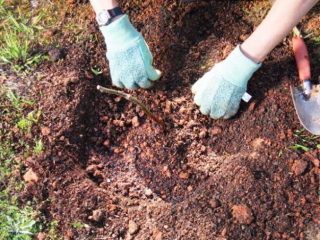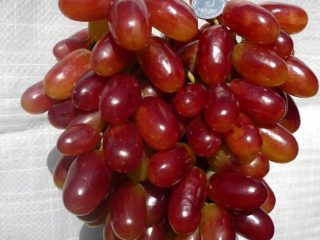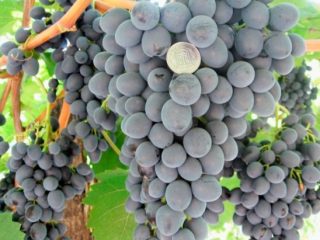Content
Many novice gardeners who decide to start their own vineyard are often intimidated by the so-called technical grape varieties. Some even think, due to their inexperience, that these grapes are generally unsuitable for food, and can only be used for wine after appropriate processing. Of course, such ideas about technical grape varieties are fundamentally wrong, especially since most of them have quite high taste characteristics. By the way, have you ever noticed how much pleasure small children prefer technical grape varieties to table grapes? The explanation is quite simple - most technical varieties have a high sugar content, which is necessary for the preparation of high-quality wines. In addition, it is the technical grape varieties that contain more health-promoting elements, amino acids and vitamins. And children feel this very well intuitively.
The Crystal grape is considered a typical technical or wine variety. Which does not prevent it from being used for making juices, compotes, jellies and marshmallows.If you are going to plant a vineyard in one of the regions north of the Voronezh region, then in this case the Crystal grape variety, due to its greater unpretentiousness, will be an excellent choice for you not only for making wine and other drinks, but also for drinking it fresh. In this case, a photo and description of the Crystal grape variety, as well as reviews from those who grew it on their site, will allow you to finally make your choice.
Description of the variety
Hungarian breeders once did a good job crossing Amur grapes with Challoczy Lajos, and then the resulting hybrid was again crossed with the universal Hungarian variety Villar blanc. Thanks to Amur grapes, Crystal has developed good frost resistance and unpretentiousness to many unfavorable conditions and diseases. And from Villars Blanc he took good taste properties and resistance to mildew and gray rot.
In 2002, the Crystal grape variety was included in the Russian state register and recommended for cultivation in the North Caucasus and Lower Volga regions. The originator was the All-Russian Research Institute of Viticulture and Winemaking named after. Potapenko, located in Novocherkassk, Rostov region.
It must be borne in mind that in the vastness of Ukraine, a hybrid form of the Black Crystal grape appeared relatively recently, which has nothing to do with ordinary Crystal. It was bred by amateur winegrower V.M. Kalugin, according to his statement, by crossing Talisman and a Bulgarian variety with very large Velika berries. The hybrid form may be interesting, but there is almost no reliable information about it at the moment, so any information about this variety is subject to additional verification.
Crystal grapes belong to very early varieties in terms of ripening; the berries acquire a marketable appearance, as a rule, 110-115 days after the buds begin to awaken. In the middle zone, this occurs approximately in the middle to second half of August. But usually, if you plan to use the Crystal to make wine, it is allowed to hang for some more time for sufficient accumulation of sugar in the berries and their final ripening. You can use the berries for food much earlier if you are satisfied with their taste.
True, at the same time, the acidity of the berries decreases to 4 g/l, which is good for fresh consumption, but may not have a very good effect on the quality of the wine.
The bushes usually have medium vigor. A curious feature of the Crystal variety is the possibility of leaves appearing on the same bushes with varying degrees of dissection. The variety is able to demonstrate good yield indicators, since 85-90% of the total number of fruit-bearing shoots is observed. On average, the yield of Crystal grape bushes per hectare is about 160 centners; in favorable conditions it can reach 200 centners/ha.
The ripening rate of shoots is excellent, reaching 100%. The color of young shoots is reddish. On average there are about 1.3 bunches per shoot.
The bushes are prone to thickening, so it is necessary to regularly remove the stepsons; it is especially important to carry out this procedure before flowering, so that the green mass does not take away nutrition from the flower stalks.
The rooting ability of cuttings of this grape variety is excellent. They simply take root in the ground without any problems, even without the use of special root formation stimulants. Cuttings also grow well with almost any rootstock.
Crystal's flowers are bisexual, so it does not require additional pollinators, while it itself can serve as an excellent pollinator for varieties with female flowers.
The bushes have increased winter hardiness, up to -29°C, although according to reviews from gardeners, when growing Crystal in the middle zone, it still requires shelter.
A very attractive characteristic of this variety is the presence of genetic immunity to gray rot, which is very important in case of possible damp and rainy weather during berry ripening.
Crystal grapes are also characterized by increased resistance to major fungal diseases: to oidium - 2.5 points, to mildew - 2 points (on a five-point scale, in which 0 is complete resistance).
Characteristics of bunches and berries
The Crystal grape variety is distinguished by the following characteristics of clusters and berries:
- The bunches have a predominantly conical or cylindrical-conical shape and are of medium density.
- The size of the bunches is average; the weight of one bunch can vary from 180 to 200 grams.
- The berries and clusters are well attached to the stalk, so they do not fall off and can hang on the bush for a long time.
- The berries of the Crystal grape cannot be called large; the weight of one grape is 1.8-2.5 grams.
- The berries are round or slightly oval in shape, the color can vary from yellow to white-green, and in bright sunlight a slight pinkish color may appear.
- The berries of this variety are characterized by a well-defined prune or waxy coating that covers the skin and provides additional protection against the penetration of harmful microorganisms.
- The skin itself is very durable, which is typical for most technical grape varieties.
- But the pulp is very juicy, tender, good harmonious taste without additional impurities.
- The grapes gain sugar content up to 18-19 Brix, and acidity in the first period of ripening is 6-7 g/l. As mentioned above, with prolonged stay on the bushes, the acidity begins to decrease and reaches 4-5 g/l. When grown in the southern regions or in a wall culture on the south side, Crystal is capable of gaining sugar up to 23 Brix.
- The main use of Crystal grapes is the production of dry table wines, such as Sherry. Tasters rate the taste of table wine made from Crystal grapes at 8.5 points, and sparkling wine at 9.1 points.
- You can also make very tasty juice from this grape variety, with the juice content in the berries being 70%.
- Of course, there are seeds in the berries, but they are not very noticeable when eating; the skin is more noticeable.
- Cracking of berries and peas are not observed in grapes, but the lower clusters may begin to wilt if stored on the bushes for a long time.
Features of cultivation
Crystal grapes begin to bear fruit 2-3 years after planting. Beginner gardeners should note that the first two years after planting should not test the bushes for frost resistance - it is advisable to cover them. As the vines age, they can simply be lowered to the ground, allowing them to be covered with snow. And in the southern regions you can even try leaving shoots on trellises for wintering.
It is better to do the pruning rather short – 2-3 eyes. The optimal number of buds left for an adult bush is about 60.
The variety is quite moisture-loving; if there is a lack of water, it may not perform well.
Grapes of this variety respond well to fertilizing with microelements, especially before flowering, since, for example, a lack of boron and zinc can negatively affect the formation of ovaries.
The thickening of the bush should also not be allowed, because this may cause the ovaries to fall off and, as a result, the yield will decrease and the appearance of the bunches will deteriorate.
Reviews from gardeners
Crystal grapes are very popular both among professional winegrowers who grow them exclusively for making wine, and among amateur summer residents.
Conclusion
Crystal berries are not very marketable and, despite being fairly well preserved, are unlikely to be too attractive to buyers. But in terms of taste, it can easily compete with many table varieties, plus it is highly resistant and easy to care for. Therefore, as a home grape for personal use, it will be one of the worthy candidates.
















